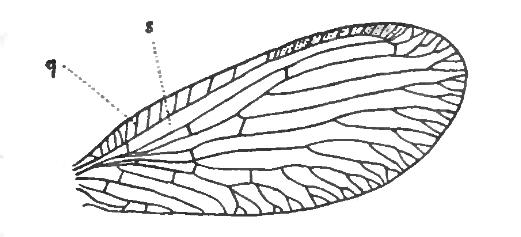|
Osmyloidea
Osmyloidea is a euneuropteran superfamily in the lacewing order Neuroptera sister to the superfamilies Dilaroidea, Mantispoidea, and the clade Neoneuroptera. The superfamily includes three living families and two extinct families described from the fossil record. Taxonomy * Nevrorthidae (Late Cretaceous-Present) * Osmylidae (Early Jurassic-Present) *Sisyridae Sisyridae, commonly known as spongeflies or spongillaflies, are a family of winged insects in the order Neuroptera. There are approximately 60 living species described, and several extinct species identified from the fossil record. Description ... (Late Cretaceous-Present) *† Archeosmylidae (Permian-Triassic) *† Saucrosmylidae (Middle Jurassic) References Neuroptera Insect superfamilies {{Neuroptera-stub ... [...More Info...] [...Related Items...] OR: [Wikipedia] [Google] [Baidu] |
Nevrorthidae
The Nevrorthidae, (often incorrectly spelled "Neurorthidae"), are a small family of winged insects of the order Neuroptera. Extant species may be described as living fossils. There are 19 extant species in four genera, with a geographically disjunct distribution, '' Nevrorthus,'' comprising 5 species with scattered distributions around the Mediterranean, '' Austroneurorthus'' with two species known from southeastern Australia, '' Nipponeurorthus'' comprising 11 species known from China and Japan, and '' Sinoneurorthus'' known from a single species described from Yunnan Province, China. They are traditionally placed in the Osmyloidea, alongside Osmylidae and the spongillaflies (Sisyridae) as their closest relatives, while some research has considered them to be the sister group to the rest of Neuroptera. The larvae have unique straight jaws that are curved at the tips, and live as unspecialised predators in the sandy bottom sediments of clear, fast flowing mountain rivers and st ... [...More Info...] [...Related Items...] OR: [Wikipedia] [Google] [Baidu] |
Osmylidae
Osmylidae are a small family of winged insects of the net-winged insect order Neuroptera. The osmylids, also called lance lacewings, stream lacewings or giant lacewings, are found all over the world. There are around 225 extant species. Description and ecology Adult osmylids are small to moderately-sized net-winged insects, with wingspans ranging from 1.4 to 3 cm. Smaller members resemble typical green lacewings, and larger species resemble antlions. Many species, namely those of the type genus '' Osmylus'', have spotted wings. The thin antennae are short. They have two compound eyes, as well as three ocelli in between. Adult osmylids, like green lacewings (some of which are colloquially known as "stinkflies"), have prothoracal glands which produce foul-smelling compounds used to deter would-be predators. Their larvae are superficially similar to those of spongillaflies (Sisyridae). They have peculiar mouthparts which look like a thin forceps with the ends bending out ... [...More Info...] [...Related Items...] OR: [Wikipedia] [Google] [Baidu] |
Sisyridae
Sisyridae, commonly known as spongeflies or spongillaflies, are a family of winged insects in the order Neuroptera. There are approximately 60 living species described, and several extinct species identified from the fossil record. Description In general appearance, the adults resemble some brown lacewings (Hemerobiidae). The forewings of spongillaflies have a span of 4–10 millimetres. The greyish or brownish wings have few cross veins except in the costal field, and most of these are not forked. The subcostal (Sc) and radial (R1) veins are fused near the wingtip. The larvae of spongillaflies look rather bizarre. Similar to those of some osmylids (Osmylidae) at first glance, they have spindly legs on a bulky thorax, long antennae, and flexible, threadlike mouthparts. However, the second and third instars carry seven pairs of jointed, movable tracheal gills beneath their plump abdomen. These gills are possessed by no other extant insect family, and readily distinguish them ... [...More Info...] [...Related Items...] OR: [Wikipedia] [Google] [Baidu] |
Neuroptera
The insect order Neuroptera, or net-winged insects, includes the lacewings, mantidflies, antlions, and their relatives. The order consists of some 6,000 species. Neuroptera can be grouped together with the Megaloptera and Raphidioptera in the unranked taxon Neuropterida (once known as Planipennia) including: alderflies, fishflies, dobsonflies, and snakeflies. Adult Neuropterans have four membranous wings, all about the same size, with many veins. They have chewing mouthparts, and undergo complete metamorphosis. Neuropterans first appeared during the Permian period, and continued to diversify through the Mesozoic era. During this time, several unusually large forms evolved, especially in the extinct family Kalligrammatidae, often called "the butterflies of the Jurassic" for their large, patterned wings. Anatomy and biology Neuropterans are soft-bodied insects with relatively few specialized features. They have large lateral compound eyes, and may or may not also have oce ... [...More Info...] [...Related Items...] OR: [Wikipedia] [Google] [Baidu] |
Dilaroidea
Dilaridae is a family of Euneuropteran insects in the order Neuroptera, known as "pleasing lacewings". They were formerly placed in the paraphyletic superfamily Hemerobioidea, though the group is currently placed in the monophyletic superfamily Dilaroidea as a sister group to Mantispoidea and Osmyloidea. There are about 9 genera and at least 100 described species in Dilaridae. Genera These genera belong to the family Dilaridae: * '' Berothella'' * †'' Cascadilar'' - (Priabonian Baltic amber,) * †'' Cretadilar'' - ( Cenomanian. Burmese amber, Myanmar) * †'' Cretodilar'' - (Cenomanian Burmese amber, Myanmar) * '' Dilar'' * '' Lidar'' * ''Nallachius'' * '' Neonallachius'' Other genera previously considered to belong to family as the subfamily Cretanallachiinae have subsequently been moved to Kalligrammatidae Kalligrammatidae, sometimes known as kalligrammatids or kalligrammatid lacewings, is a family of extinct insects in the order Neuroptera (lacewings) ... [...More Info...] [...Related Items...] OR: [Wikipedia] [Google] [Baidu] |
Mantispoidea
Mantispoidea is a superfamily of euneuropteran insects in the order Neuroptera. The group was formerly placed in the paraphyletic suborder Hemerobiiformia, but is now considered sister to the superfamilies Dilaroidea and Osmyloidea. Mantispoidea contains three living families and one extinct family described from the fossil record. Taxonomy *Berothidae (Late Jurassic-Present) *Mantispidae Mantispidae, known commonly as mantidflies, mantispids, mantid lacewings, mantisflies or mantis-flies, is a family of small to moderate-sized insects in the order Neuroptera. There are many genera with around 400 species worldwide, especially in ... (including † Dipteromantispidae) (Jurassic-Present) *† Mesoberothidae (including † Mesithonidae) (Triassic) * Rhachiberothidae (Early Cretaceous-Recent) References External links * * Insect superfamilies {{Neuroptera-stub ... [...More Info...] [...Related Items...] OR: [Wikipedia] [Google] [Baidu] |


